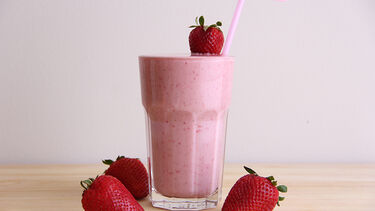
Did you know that your gut holds a key to better health and wellbeing? Your thanks must go to the trillions of gut bacteria and other microorganisms – sometimes known as ‘the gut microbiota’ – and the role they play in your digestion.
It sounds technical but think of your digestive system as a factory that turns food into fuel. Your gut microbiota are the factory workers. The more diverse the workers and the better the working conditions, the happier and healthier your gut will be.
This is important because a healthy gut has been linked to not only digestive health but also to brain function, the immune system and metabolism (how your body converts food into energy).
Jean Hailes Naturopath Sandra Villella and Accredited Practising Dietitian Dr Stephanie Pirotta explain how to nourish your gut bacteria by choosing the best everyday foods. Here are their top picks and recipes.
Prebiotics are a type of fibre (but not all fibre is a prebiotic). This type of fibre passes through the gut undigested.
Put simply, prebiotics are fuel for healthy gut bacteria, so it's important to eat enough prebiotics to keep the populations alive and healthy.
Prebiotics occur naturally in all vegetables but some have particularly high levels. These include:
Prebiotics also occur in legumes such as chickpeas, lentils and red kidney beans.
Brown rice is also a prebiotic. The nutrients in this healthy wholegrain help to feed healthy gut bacteria. So to get the benefits, opt for brown rice over white rice wherever possible.
Red and black rice are also good options for the gut. And, luckily, they are becoming more available in some supermarkets.
Recipe: Red rice and aduki bean salad
Recipe: Mediterranean-inspired roast vegie and brown rice salad
Oats contain a unique type of fibre that nourishes and restores healthy gut bacteria. Dr Pirotta says it’s important to go for whole, rolled or steel cut oats, rather than quick oats. “This is because whole oats include the outer layer of the grain, which is where all the good nutrients and fibre are found,” she explains.
Oats are a cheap and easy food to eat regularly and they are especially suited to breakfast – in porridge and muesli, or add them to a smoothie to help thicken it.
These tiny brown or golden-coloured seeds are high in fibre and healthy fats. Also known as ‘flaxseeds’, linseeds help to create a healthy environment in the gut where good bacteria want to grow and live.
Ms Villella recommends freshly grinding linseeds at home in a coffee grinder or spice grinder. Ground seeds can then be stored for up to two weeks in an airtight container in the fridge.
You can still eat whole (unground) linseeds, but you won’t absorb as much of the fibre.
You can also buy pre-ground linseeds, but you might miss out on the healthy fats. After being ground the healthy fats start breaking down (oxidising). So fresh is best!
Get more linseeds into your daily diet by trying out Ms Villella's recipes, or simply sprinkle a tablespoon or two of ground seeds over your porridge or muesli in the morning.
Another way to support your populations of healthy bacteria is by eating them! Yoghurts often contain healthy gut bacteria, but it's important to check the labels. Some products list the type and quantity of good bacteria. Ms Villella recommends eating yoghurt that contains around one billion good bacteria per serve.
Kefir is a fermented milk drink and is a bit like thin yoghurt. Kefir often contains even greater amounts of healthy bacteria than yoghurt. It’s available to buy in major supermarkets and health food stores, or some people make it at home. It can be quite sour to taste, but many people enjoy it as part of their breakfast – added to smoothies or with fruit.
Time for some good mood food?
Learn how diet, gut health and mental health are all connected.
Go to articleAll reasonable steps have been taken to ensure the information created by Jean Hailes Foundation, and published on this website is accurate as at the time of its creation.
© 2025 Jean Hailes Foundation. All rights reserved. This publication may not be reproduced in whole or in part by any means without written permission of the copyright owner. Contact: licensing@jeanhailes.org.au